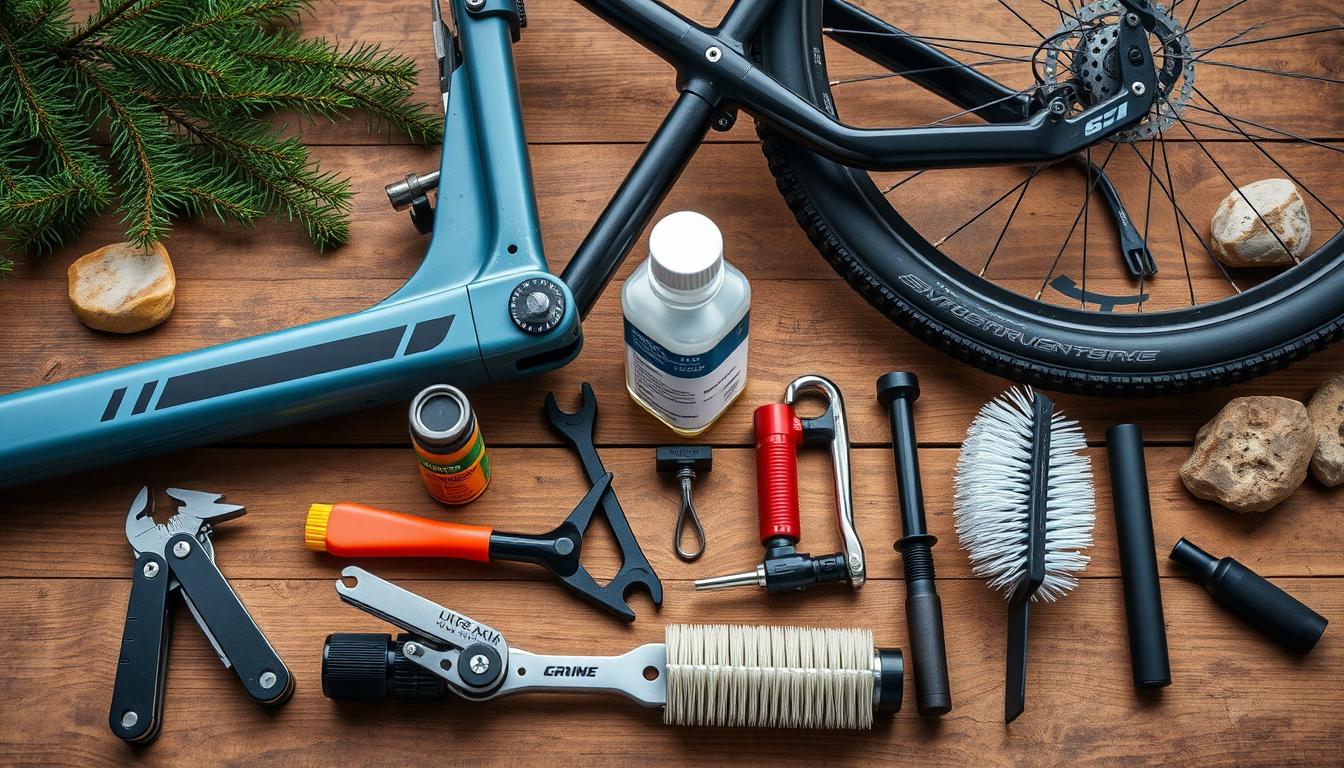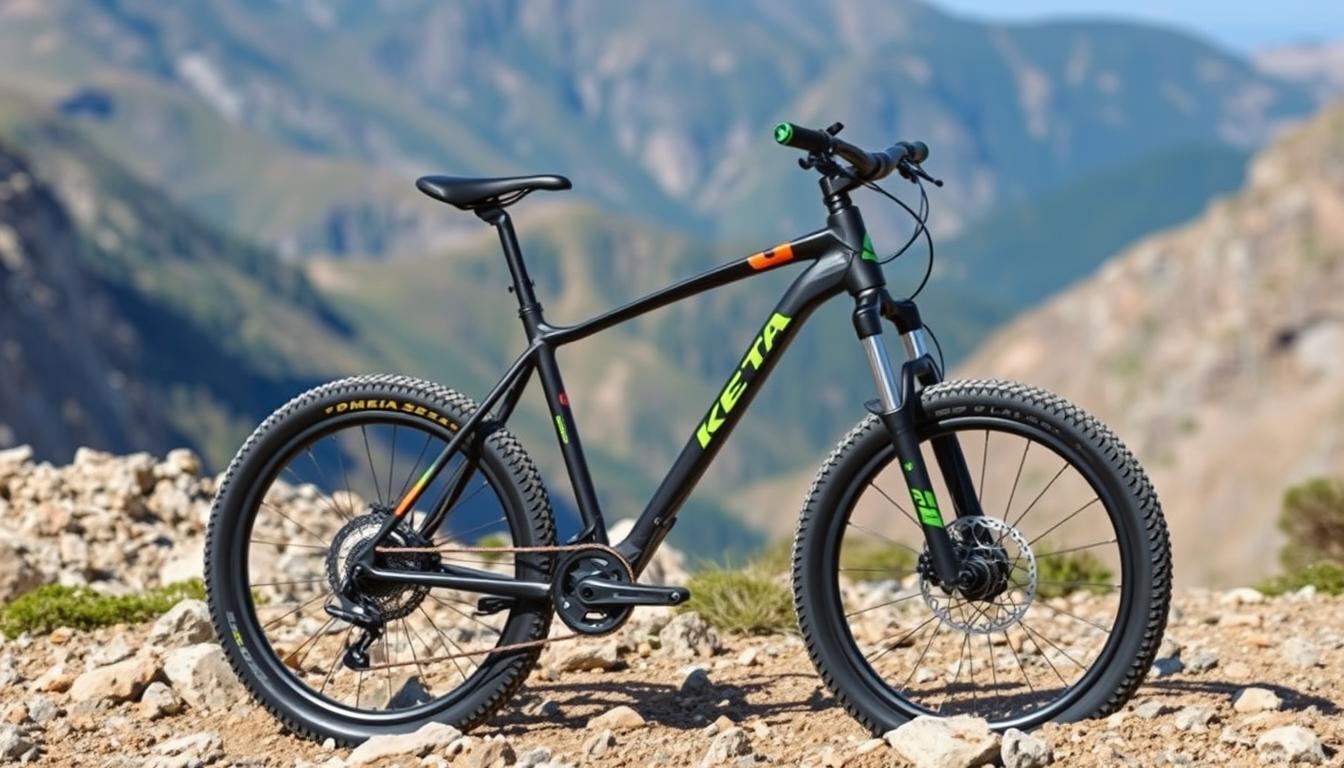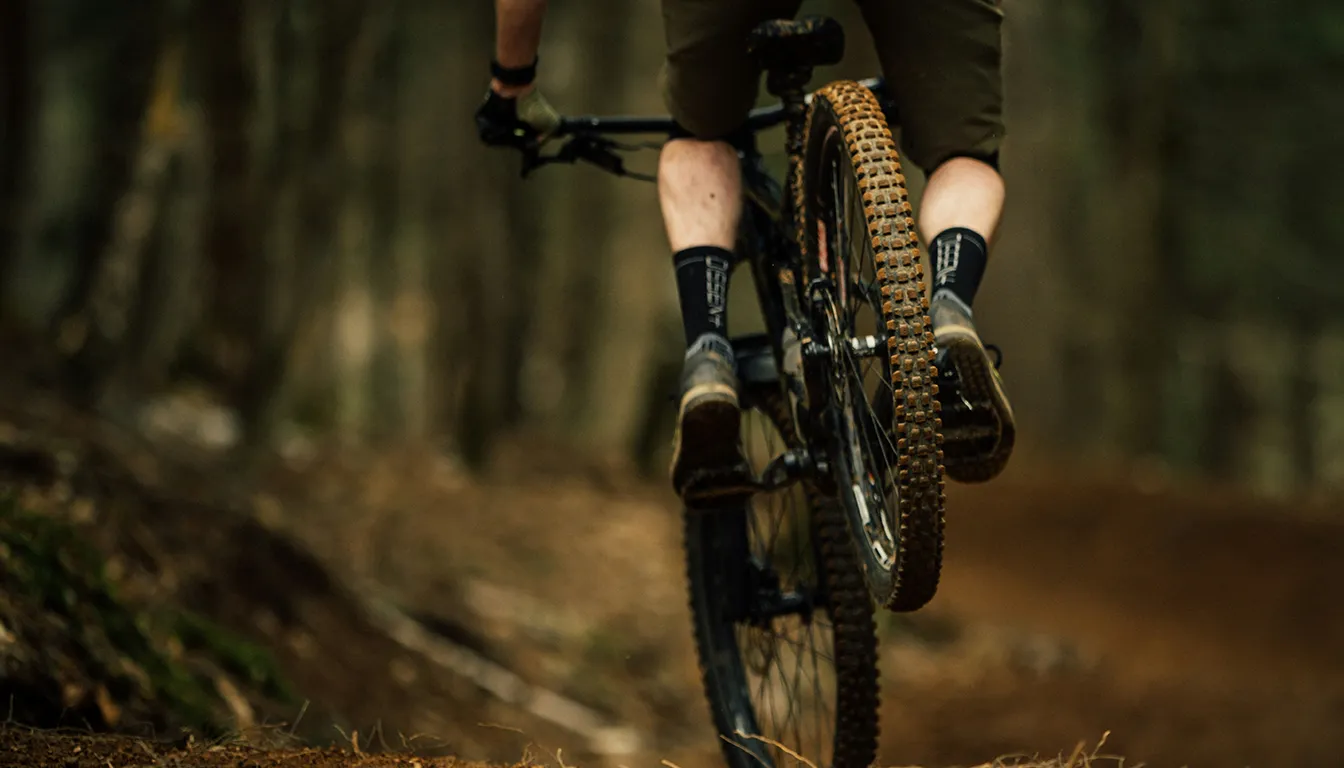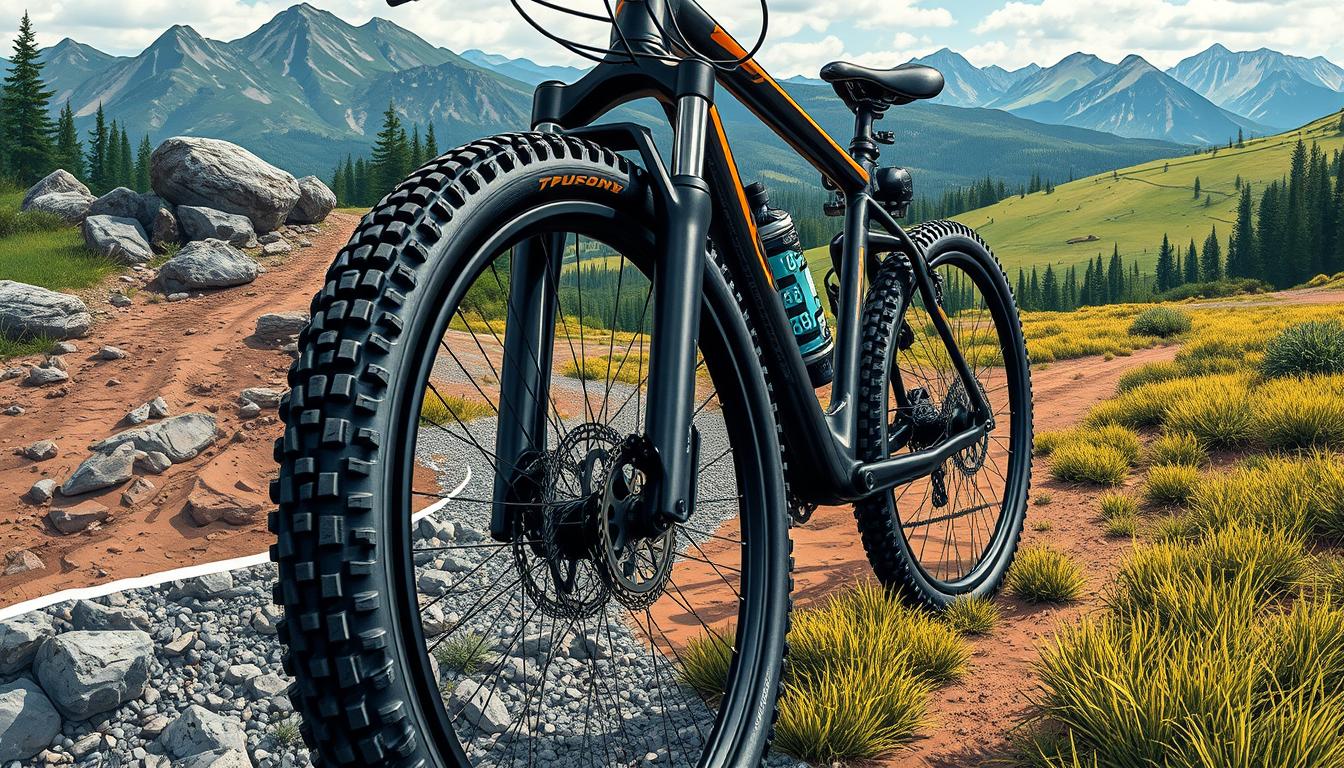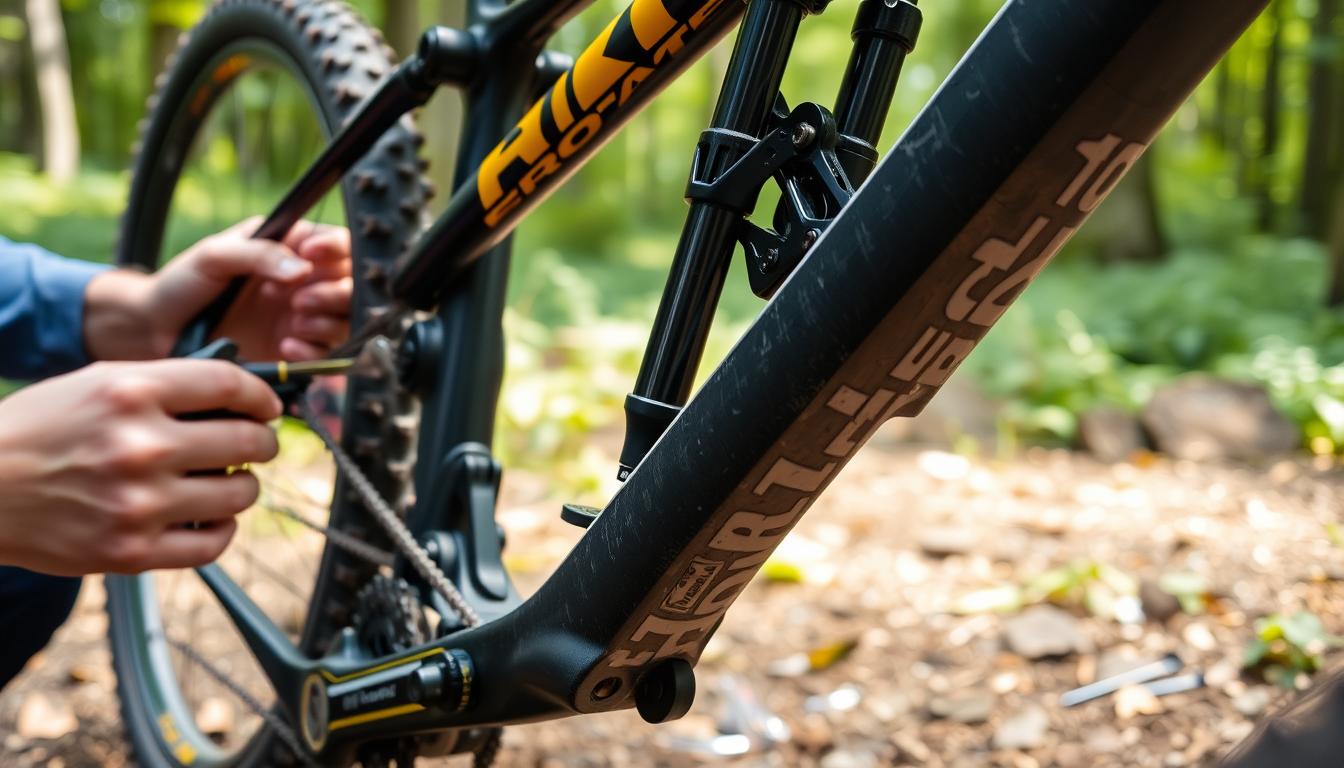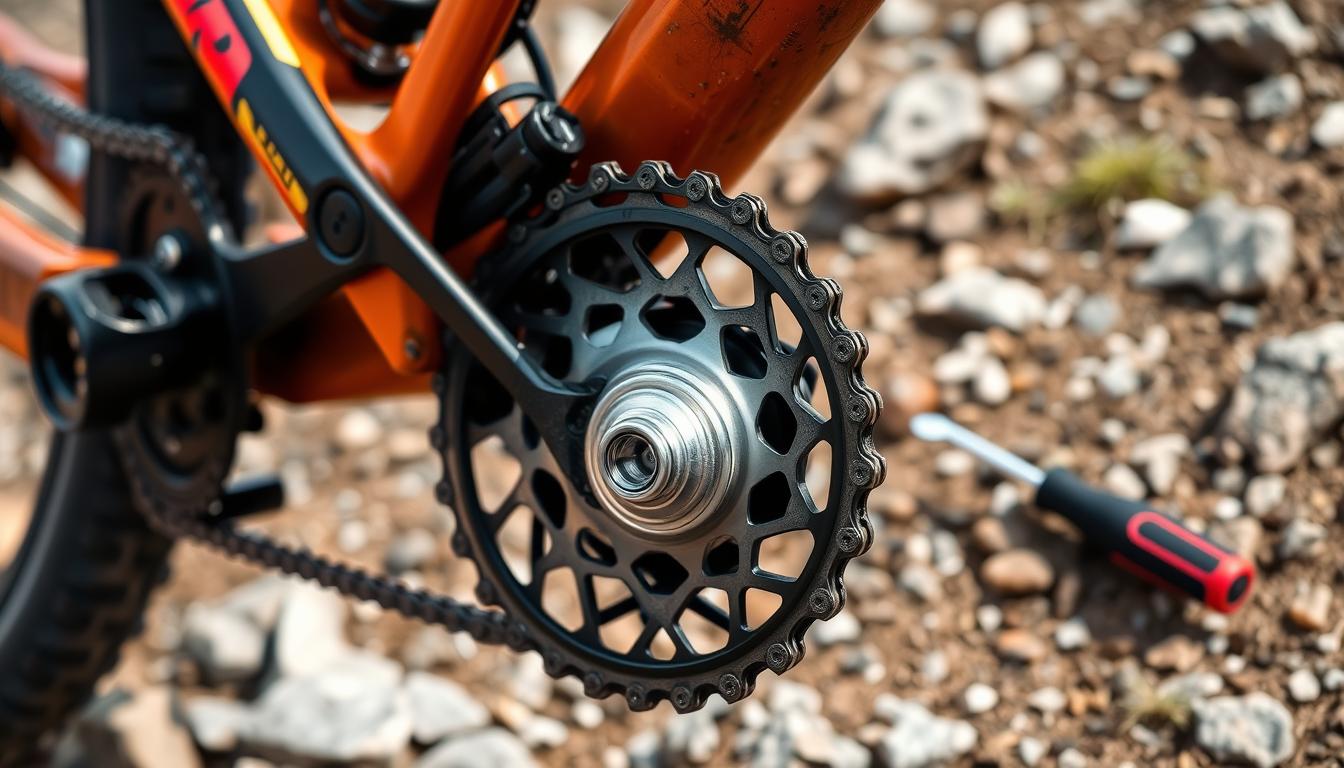Mountain bike maintenance is crucial for top performance and longevity. Grasping the basics of bicycle servicing can save time, money, and prevent breakdowns on tough trails.
Proper MTB upkeep isn’t just about looks. It’s about ensuring optimal performance and safety. Regular bike care requires a systematic approach to maintaining each vital component.
Your bike faces significant stress during rides, from muddy trails to rocky paths. A thorough maintenance routine will extend your bike’s life and improve riding efficiency.
Consistent, thoughtful care is the foundation of a reliable mountain bike. It also helps maintain its resale value.
This guide covers essential techniques and practical tips for top-notch bike condition. You’ll learn recommended maintenance schedules to keep your bike adventure-ready.
Essential Tools and Supplies for Mountain Bike Maintenance
Proper mountain bike upkeep requires the right cleaning supplies and repair tools. A well-stocked maintenance kit can prevent frustrating breakdowns on the trail.
Your kit should include items for both cleaning and repairs. This ensures you’re ready for any situation during your rides.
Basic Cleaning Materials
Every cyclist needs a comprehensive set of cleaning supplies. Your bike cleaning kit should include these essentials:
- Degreasing solution
- Soft-bristled brushes
- Microfibre cloths
- Bike-specific cleaning detergent
Specialised Tools for Repairs
Quality repair tools are crucial for effective bike maintenance. Essential tools for your kit include:
- Allen key set (sizes 2mm to 8mm)
- Torx keys (T25)
- Cable cutters
- Chain tool
- Needle-nose pliers
“A good set of tools is like a cyclist’s best friend on the trail”
Lubricants and Degreasers
Proper bike lubricants keep your mountain bike running smoothly. Recommended lubricants for your kit include:
- Wet conditions chain lubricant
- Dry conditions chain lubricant
- Ceramic-based lubricants
- Multi-purpose bicycle grease
Pro tip: Use Kaizen Foam to organise your bicycle maintenance kit. This keeps tools secure and easy to find.
A well-maintained toolkit ensures your mountain bike stays in top shape. This preparation allows you to enjoy every adventure with confidence.
How to Maintain a Mountain Bike?
Proper mountain bike upkeep ensures top performance and longevity. A well-planned maintenance schedule can prevent breakdowns and save you money. Regular care keeps your bike in prime condition.
Your MTB cleaning routine should be thorough and methodical. Consistent care is vital for keeping bikes in top shape. This approach is favoured by professional cyclists and seasoned riders.
Regular Cleaning Routine
A comprehensive cleaning process involves several critical steps:
- Clean the chain first as a priority
- Use appropriate degreasers for stubborn dirt
- Wipe down the entire frame
- Check for any visible damage or wear
Post-Ride Maintenance Checklist
After each ride, perform these essential checks:
- Check tyre pressure
- Inspect brake pad thickness (ensure at least 3mm remains)
- Lubricate the chain
- Examine suspension components
*”Preventative maintenance is cheaper than replacement”* – Mountain Bike Maintenance Experts
Professional Service Intervals
Home maintenance is crucial, but professional bike service remains important. Brands recommend specific service intervals:
- Fork lowers: Service every 3-6 months
- Rear shock: Full service every 6-12 months
- Complete professional bike service: Annually or every 500 miles
Local bike shops offer expert guidance, regardless of where you bought your bicycle. Regular maintenance keeps your mountain bike reliable, safe, and performing at its best.
Drivetrain Care and Maintenance
Your mountain bike’s drivetrain is its vital performance engine. Regular upkeep ensures smooth rides and longer-lasting parts. Proper chain care is essential for top-notch cycling performance.
Experts suggest a methodical approach to drivetrain maintenance. Grime can slash your bike’s efficiency and cause costly damage. Clean the chain after each ride with bike-specific degreasers.
Inspect parts for wear and potential issues. Use suitable lubricants for various riding conditions.
- Clean the chain after each ride using bike-specific degreasers
- Inspect drivetrain components for wear and potential damage
- Use appropriate lubricants for different riding conditions
Cassette cleaning needs care. Avoid harsh chemicals that might damage delicate components. Opt for bike-friendly, biodegradable cleaners instead.
“A clean drivetrain is a happy drivetrain” – Professional Mountain Bike Mechanic
Proper derailleur adjustment ensures smooth gear shifts. Unusual sounds while pedalling signal maintenance needs. Check chain wear regularly to prevent early cassette and chainring replacement.
- Apply lubricant to chain rollers
- Rinse thoroughly after degreasing
- Use wet lube for muddy conditions
- Use dry lube for dusty environments
Time spent on drivetrain care saves money. It also makes for more enjoyable rides. Your bike will thank you with top performance.
Proper Tyre Care and Pressure Management
Mountain bike tyres connect your bike to the terrain. Proper tyre care and pressure enhance your ride, safety, and performance. Understanding these aspects can transform your cycling experience.
Effective tyre management starts with grasping key principles. Different trails require unique pressure approaches. Knowing how to adjust can make a significant difference.
Checking Tyre Pressure
Correct MTB tyre pressure is crucial for peak performance. Here are some essential guidelines to follow:
- Baseline pressures: 25-30 PSI (rear), 20-25 PSI (front)
- Adjust pressure based on rider weight and terrain
- Heavier riders need slightly higher pressures
- Reduce pressure by 2-4 PSI on rough terrain for enhanced grip
*Always check tyre pressure before each ride to ensure maximum safety and performance.*
Inspecting Tyre Wear and Damage
Regular tyre checks help prevent potential failures. Look out for these key areas:
- Check sidewalls for cuts or abrasions
- Examine tread depth for wear patterns
- Remove embedded debris carefully
- Replace tyres showing significant wear
Tubeless Tyre Maintenance
Tubeless tyres need special care. Keep these points in mind:
- Check sealant levels every 2-3 months
- Rotate tyres to ensure even wear
- Inspect for slow leaks regularly
- Top up sealant as recommended by manufacturer
Pro tip: Carry a portable pump and spare sealant on longer rides for emergency maintenance.
Suspension Setup and Maintenance
Mountain bike suspension is crucial for your ride’s performance. Understanding MTB suspension setup can enhance your cycling experience. It provides comfort and control on challenging terrains.
Proper suspension setup involves several key steps. Riders should focus on fork maintenance and shock absorber care. These elements ensure optimal bike performance.
- Check suspension sag between 25-30% for rear shock
- Adjust fork sag to 15-20 percent of total travel
- Set rebound settings to match your riding style
Regular fork maintenance includes cleaning and inspecting stanchions. Dirt and grime can quickly degrade suspension performance. Use specialised cleaning products to protect sensitive parts.
Suspension setup is not just about technical adjustments, but understanding how your bike responds to different terrains.
Advanced riders can use volume spacers to fine-tune suspension progression. Air suspension allows easy adjustments with a shock pump. Coil shocks need precise spring rate selection based on rider weight.
Regular servicing is vital for shock absorber care. Professional service intervals range from 50 to 100 riding hours. This depends on usage and manufacturer recommendations.
Common Issues and Troubleshooting
Mountain bike maintenance is vital for a safe and smooth ride. Proper troubleshooting helps riders spot and fix problems early on. This can prevent minor issues from becoming major headaches.
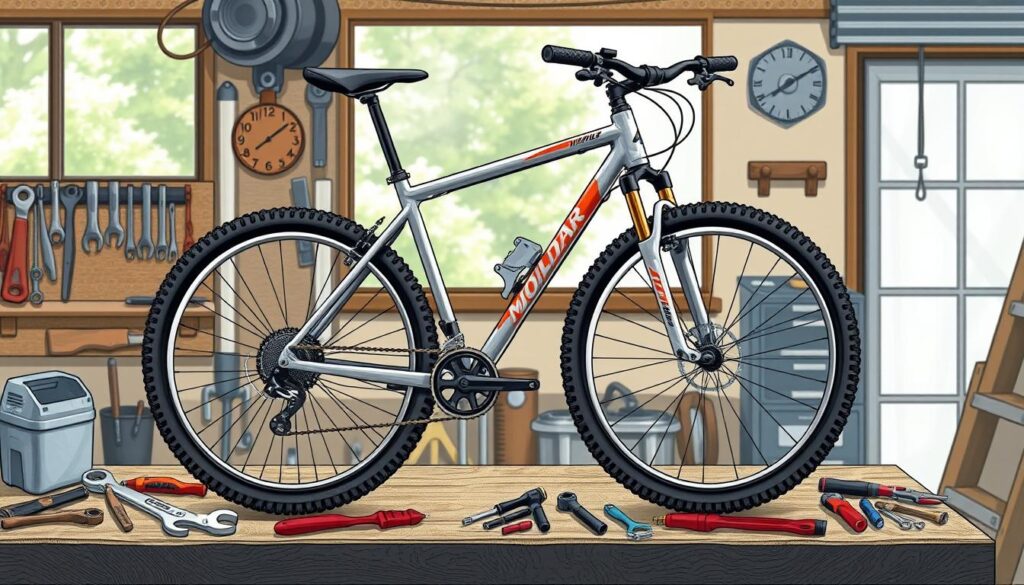
Understanding common MTB repair challenges can save you time and money. It can also reduce frustration on the trail. Let’s look at some key areas of bicycle noise diagnosis and problem-solving.
Identifying Strange Noises
Odd sounds on your mountain bike might point to mechanical issues. Here are some common noise sources to check:
- Creaky bottom brackets
- Loose bolts and components
- Worn bearings
- Chain and drivetrain misalignment
To find these noises, check each part carefully. Tighten loose bolts, clean and lubricate moving parts, and replace worn components as needed.
Shifting Problems
Smooth gear shifting is key for a great mountain bike ride. Common shifting issues include:
- Misaligned derailleur
- Cable tension problems
- Worn cassette or chain
- Bent derailleur hanger
Precise adjustments and regular maintenance can prevent most shifting problems.
Brake Maintenance
Reliable brakes are crucial for mountain bike safety. Key brake maintenance tasks include:
- Inspecting brake pad wear
- Cleaning disc rotors
- Checking hydraulic fluid levels
- Adjusting brake alignment
Regular checks and quick repairs ensure top brake performance. This keeps riders safe during tough trail conditions.
Conclusion
Regular MTB maintenance is vital for keeping your bike in top shape. It extends your bicycle’s life and ensures peak performance on tough trails. Proper care prevents costly repairs and leads to smoother, more reliable rides.
Your upkeep routine should include weekly cleaning and monthly checks. Focus on the drivetrain, suspension, tyres, and brakes. Use quality tools and lubricants made for mountain bikes. Addressing small issues quickly can prevent bigger problems later.
Professional servicing is crucial for comprehensive bike care. Experts should handle complex repairs and annual checks. This ensures your mountain bike stays in excellent condition. Pay attention to unusual sounds or changes in performance.
Consistent care makes mountain biking more enjoyable. Your dedication to bike upkeep will improve performance and safety. It will also lead to countless memorable adventures on the trails.
FAQ
How often should I clean my mountain bike?
Clean your mountain bike after every ride or weekly. Wipe down the frame, check tyre pressure, and lubricate the chain. Do a thorough cleaning regularly to prevent wear and maintain performance.
What essential tools do I need for mountain bike maintenance?
A basic maintenance kit includes cleaning supplies, specialised tools, and lubricants. You’ll need rags, brushes, a chain cleaner, and tyre pressure gauge. Don’t forget Allen keys, screwdrivers, and a torque wrench for mechanical tasks.
How do I maintain my bike’s drivetrain?
Clean the chain, cassette, and chainrings with a degreaser and brush. Lubricate the chain by applying oil to each roller. Check for chain wear and replace when needed.
Adjust the derailleur to ensure smooth shifting and prevent premature wear.
How often should I check my bike’s tyre pressure?
Check tyre pressure before every ride using a gauge. Adjust based on riding conditions and personal preference. Inspect tyres for wear, cuts, or embedded objects.
For tubeless setups, ensure proper sealant levels and check for slow leaks.
What’s involved in suspension maintenance?
Set the correct air pressure in forks and shocks based on your weight. Clean and lubricate suspension stanchions after rides. Check for oil leaks or unusual noises.
Perform regular servicing, such as oil changes and seal replacements, as recommended by the manufacturer.
How can I troubleshoot common bike issues?
Check for loose bolts, creaky bottom brackets, or worn bearings to address strange noises. Adjust cable tension or check for bent derailleur hangers to resolve shifting problems.
Maintain brakes by inspecting pad wear, cleaning rotors, and making necessary adjustments. Address issues promptly to prevent major problems during rides.
When should I seek professional bike servicing?
Seek professional servicing for complex tasks like suspension service or intricate mechanical issues. Consult a bike mechanic if you’re unsure about a repair or lack the necessary tools.
Professional help ensures proper care and prevents potential damage to your bike.
How can I extend the life of my mountain bike?
Regular maintenance is crucial for extending your bike’s life. Clean and lubricate consistently, address issues promptly, and replace worn components. Perform thorough inspections and store your bike in a dry, clean environment.
Avoid exposing your bike to extreme conditions. Follow manufacturer recommendations to improve longevity and performance.
